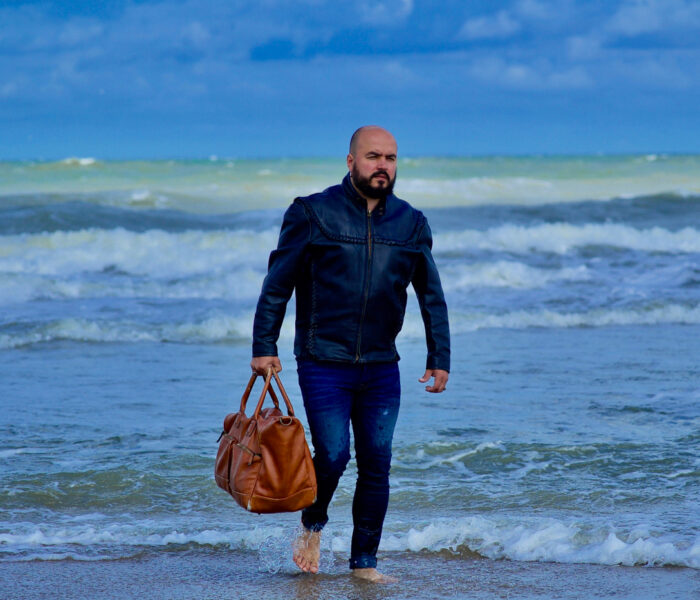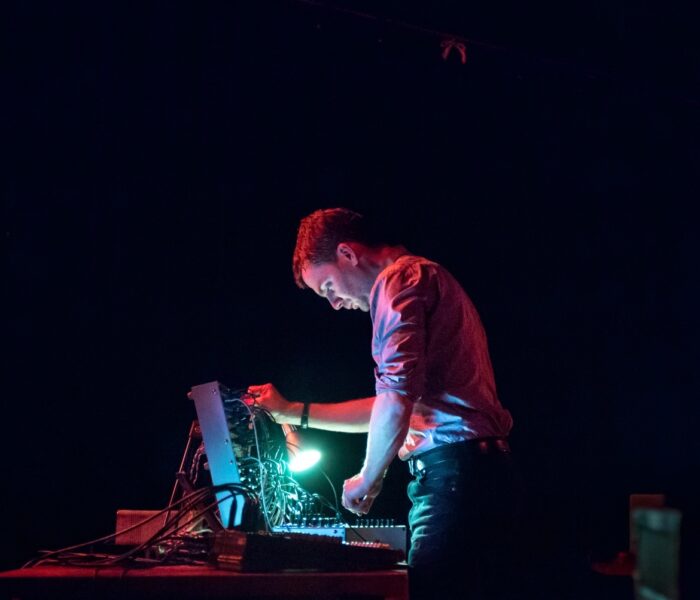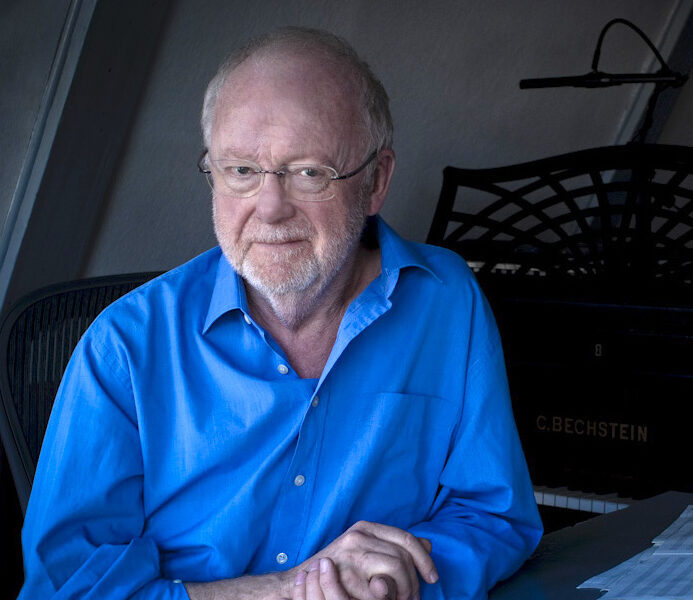The young Dutch composer Joey Roukens has become one of the great figures of contemporary creation in the Netherlands. 2022 was the year of extremes: two major creations and a long illness. Dutch journalist and author Joep Stapel, correspondent for Hémisphère son, spoke to him and painted a portrait of his boundless energy.
It was a " crazy year ", in the words of Joey Roukens, who celebrated his fortieth birthday and completed two of his greatest compositions to date, which premiered shortly after each other to great acclaim: his Requiem and his Symphony No. 1 both of which were cited in many end-of-year charts in the Dutch music press. At the same time, on a personal level, Roukens experienced the " worst year of his life ": health problems so disrupted his life that he was unable to compose for months on end.
Today, fortunately, Joey Roukens (Schiedam, 1982) is in better health. In his early forties, he already has a long career behind him, and is one of the most prominent Dutch composers of his generation. The terrible tinnitus and neuralgia from which he suffered, almost prohibiting him from sitting down and making noise unbearable, have not yet completely disappeared, but seem to be regressing. In any case, says Roukens, he is now able to manage them better. " I've decided to put my work as a composer on the back burner. I still can't sit still for long, but I'm still working on my fifth piece for string quartet.
Roukens is not the type to be downhearted, and he gives an impression of dynamism and good humor when we meet in the summer of 2023, but he has been through a very difficult period. He himself suspects that his symptoms, already latent, were suddenly aggravated to an extreme degree by stress: the completion of his two long works - commissions - and all that that entailed had taken too much out of him.
The contrast was all the greater when he suddenly found himself unable to put down on paper, or worse, listen to, a single note. For a thoroughbred music lover like Roukens, this was certainly painful. There are composers who are primarily interested in their own work, but Roukens is an avid listener who studies music history with dedication. Often called an eclectic, he is indeed, but to avoid the negative connotations this term might eventually arouse, it would perhaps be more accurate to describe him as a composer in dialogue with musical history. Provided, however, that this dialogue is based on sincere interest, for Roukens is anything but a postmodernist commenting on or parodying tradition. Quite the contrary: whether it's Gesualdo or a contemporary composer, Sibelius or John Adams, he makes the music he admires his own. The many stylistic references in his work are never gratuitous: " they are an essential part of myself ", as Roukens states in the November Music festival publication Tussen hemel en aarde (Between Heaven and Earth , 2022), dedicated to him.
Roukens studied composition at the Rotterdam Conservatory (now Codarts) and psychology at Leiden University. As a pianist, he took private lessons with the famous Ton Hartsuiker, a piano pedagogue who was one of the great ambassadors of new music in the Netherlands. He also played keyboards in pop bands. The pop influence was obvious to the eye, or ear, when, as a young composer, he produced his first orchestral scores. Or more precisely: the energy of pop music. The titles of his first compositions written for the Koninklijk Concertgebouworkest speak for themselves: Out of control (2010) and Chase (2013). The latter work, regularly performed, is like the vigorous soundtrack to a fictional chase scene in an action movie. Film music is another of his passions.
Another thing that struck me immediately was the ingenuity with which Roukens constructs a musical presentation, moving with apparent ease from one style or mood to another. The ultimate example is his highly acclaimed First Symphony, which he himself dubbed "kaleidoscopic". The work's multi-faceted character is unmistakable: Roukens is a gifted orchestrator, who knows how to make an orchestra shine or vary its colors. But above all, the symphony has a masterly architecture that captivates the listener for forty minutes. The long final movement is a grandiose adagio that elevates all that precedes it to a higher level. This sublime adagio was already heralded by Rising Phenix, a composition for orchestra and choir written by Roukens in 2014 to mark the reopening of Utrecht's TivoliVredenburg concert hall. In the second part of this piece, too, he unfurled a romantic, lively melody that was both evocative of the great symphonic tradition of a hundred years ago and resolutely contemporary.
And the end matters, as Roukens well knows. A qualified cognitive psychologist, he draws on his knowledge of observational processes when composing, and knows that there's a pic-fin rule: people base their judgment and appreciation essentially on the highlights and endings of what they've heard. The underlying complex systems, on the other hand, are barely noticed: " The auditory experience obeys laws. In my opinion, it's always the ear that comes first." Roukens' music often gives an impression of spontaneity, even impetuosity, but at the same time the listener has the impression of being led by a guide who knows exactly where he's going.
Roukens loves music in which "there's a lot going on": variations, a wide range of expressions, changing emotions and moods. The music of composers like Gustav Mahler, Charles Ives, John Adams - and Mozart, of course: " His contemporaries even said of him that he moved too quickly from one mood to another. His music changes its emotional charge very quickly. The Fantasy in C minor, K.475, is a good example. The funny thing is, we tend to see Mozart's musical language as a uniform thing. Nowadays, we often think of his music as a kind of flowery wallpaper, when in fact it's very progressive in its use of dissonance and expressive contrasts."
For comparison, listen to Roukens' In Unison (2018), the double concerto he composed for pianist brothers Lucas and Arthur Jussen. He has them play as " a single super pianist playing a single super piano ": sparkling, roller-coaster music alternates at breakneck speed with intimate serenades, dance and virtuoso rhythms.
While his early, successful compositions were characterized by fast-paced editing, boundless energy and clear pop influences, in recent years Roukens more often lets us see his contemplative side. For the time being, this evolution culminates in the Requiem he composed in 2022 for the Nederlands Kamerkoor choir and the Amsterdam Sinfonietta string orchestra, commissioned by the November Music festival and the Muziekgebouw Amsterdam. Much of the work is restrained, expressing Roukens' love of the religious music of Gesualdo, Bach and Stravinsky, using polyphonic techniques from the time of Palestrina. In the NRC daily newspaper, Roukens himself described his homage to the requiem genre as " dream music of the Renaissance ".
A contemporary composer who writes "dream Renaissance music" and wins everyone over: not so long ago, this would have been inconceivable, Roukens is well aware. At the Conservatoire, he went " through a Ligeti period ". During this period, he imitated the style and techniques of this multi-talented Hungarian modernist. After all, to be a serious composer, you had to write a certain kind of music, he thought, which is hardly surprising when you consider that the modernist canon dominated music education at least until the turn of the millennium.
But Roukens soon realized that something was wrong: " Ligeti continues to fascinate me, but the works of Xenakis or Lachenmann, two other great figures of the avant-garde, spoke to me much less. " When he produced his first "openly eclectic" tonal work, the orchestral composition 365 (2006), it was greeted with a certain amount of skepticism: what were we to make of it? Wasn't it kitsch, too easy, far too banal? Today, Roukens laughs: ""These days, the fashion is for even more tonal music. Someone like Einaudi with his extreme simplicity, enjoys incredible popularity. At the same time, the musical landscape is much more varied today than when I was a student."
For someone like Roukens, this means he doesn't have to conform to the demands of a dominant style. Basically, it's simple, he argues: " The operating principles of tonality are in our blood. It's a question of tension and release, or instability and stability. This gives music the potential to move in a direction, and helps create a dramatic discourse. Research has shown that babies already have a preference for tonal music. Even in a dodecaphonic suite, consonant intervals strike us as the ear is always on the lookout for regularities. When we look at musical traditions around the world, they are almost all diatonic. Twentieth-century European atonal music is an exception, and in our own musical history, too, it has turned out to be no more than an intermezzo."
A fascinating intermezzo, all the same: " I don't dislike it; on the contrary, I love atonal music, such as the early works of Schönberg. In terms of sound, technique and energy, it represents an incredible achievement. But it is precisely the harmony that is the least convincing aspect of this music: it has degenerated into sonority, losing some of its emotional range. In short, pitch no longer matters - even though, personally, it's what I listen to in the first place. Composers such as Alban Berg and Ligeti played on the diatonic implications of certain intervals in their works, and that's what gives their music its strength."
Roukens himself couldn't really be classified in any one group or trend, even if he is a child of his time: he's not the only one interested in pop and film music. In fact, there is no longer any real "Dutch" music, as there was in the days of Louis Andriessen and Otto Ketting, composers who shattered the hegemony of modernism with their direct, pragmatic approach. " But I consider myself lucky to have been born in the Netherlands," says Roukens. " Still,Andriessen and the others paved the way for me. In countries like Germany, France and Austria, the climate is more modernist, and I doubt I'd have the space to compose my music there. Here, I can do whatever I want. "
Joep Stapel, Nijmegen, Netherlands
With the support of Performing Arts Fund (NL)
Photos © Friso Keuris



)



